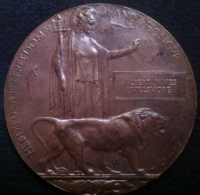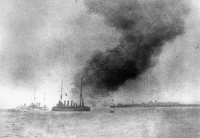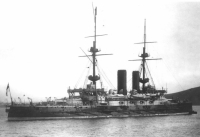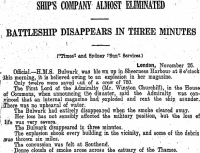A HISTORICALLY IMPORTANT MEMORIAL PLAQUE
To:
Boy 1st Class, ALBERT JAMES WILLSMORE. RN.
Who,with 800 of his shipmates was
Killed in the tragic explosion of
HMS BULWARK
at Sheerness
26th November 1914.  .
.  .
.  .
. 

HMS BULWARK
On 26th November 1914 HMS Bulwark, a 15,000 ton battleship, was moored at buoy number 17 at Kethole Reach on the River Medway.
She was taking on coal from the airship base at Kingsnorth, on the Isle of Grain. At 7.50am, as the crew who had mainly just returned from a period of leave were having breakfast, an explosion ripped the ship apart.
The explosion was heard as far away as Whitstable to the south and Southend (in Essex) to the North. Eye witnesses stated that once the smoke has cleared, there was no sign of the ship. This evidence is supported by the fact that naval divers who investigated the wreck three days after the explosion found just two large fragments of wreckage - a section of the port bow as far aft as the sick bay, and 30 feet further away, a section of the starboard bow. Debris from the explosion fell up to four miles away. In all, the explosion killed 745 men and 51 officers. Five of the 14 men who survived died later of their wounds, and almost all of the others were seriously wounded. There are mass and individual graves in Woodlands Cemetery in Gillingham, for the Bulwark's dead, who were mostly drawn from the Portsmouth area. Although the local papers immediately suspected sabotage, the subsequent naval court of enquiry (held at the Royal Naval Hospital, Gillingham) found that much of the ammunition for the ships guns had been stored in the corridors between the 11 magazines, and that either a fault with one of the shells or overheating cordite near a boiler room bulkhead could have started a chain reaction which destroyed the ship.
On the afternoon of Thursday, November 26th, 1914, Winston Churchill made the following statement to the House of Commons :
"I regret to say I have some bad news for the house. The Bulwark battleship, which was lying in Sheerness this morning, blew up at 7.35 o'clock. The Vice and Rear Admiral, who were present, have reported their conviction that it was an internal magazine explosion which rent the ship asunder. There was apparently no upheaval in the water, and the ship had entirely disappeared when the smoke had cleared away. An inquiry will be held tomorrow which may possibly throw more light on the occurrence. The loss of the ship does not sensibly affect the military position, but I regret to say the loss of life is very severe. Only 12 men are saved. All the officers and the rest of the crew, who, I suppose, amounted to between 700 and 800, have perished. I think the House would wish me to express on their behalf the deep sorrow with which the House heard the news, and their sympathy with those who have lost their relatives and friends." Entitled to a 1914-15 Star Trio.
£175